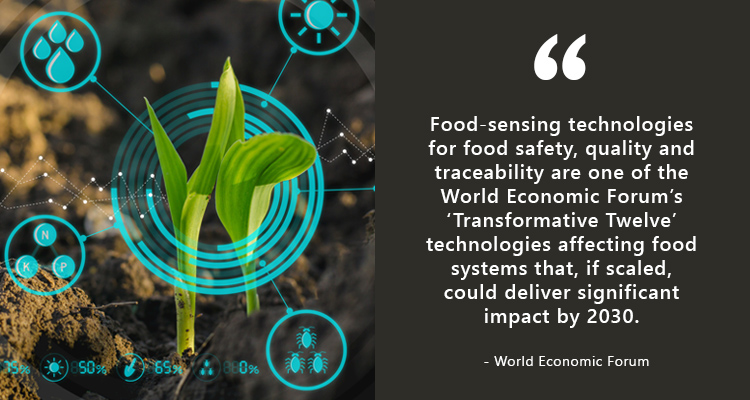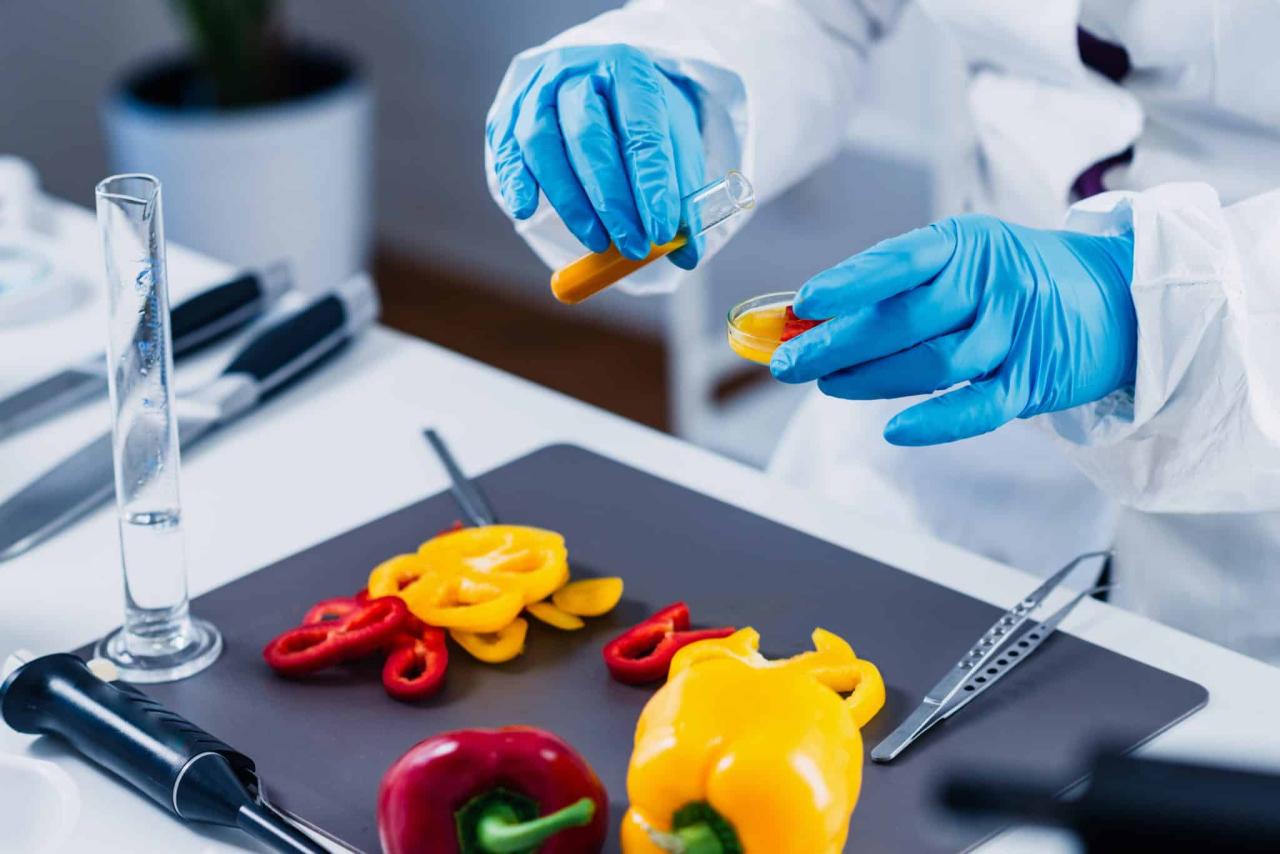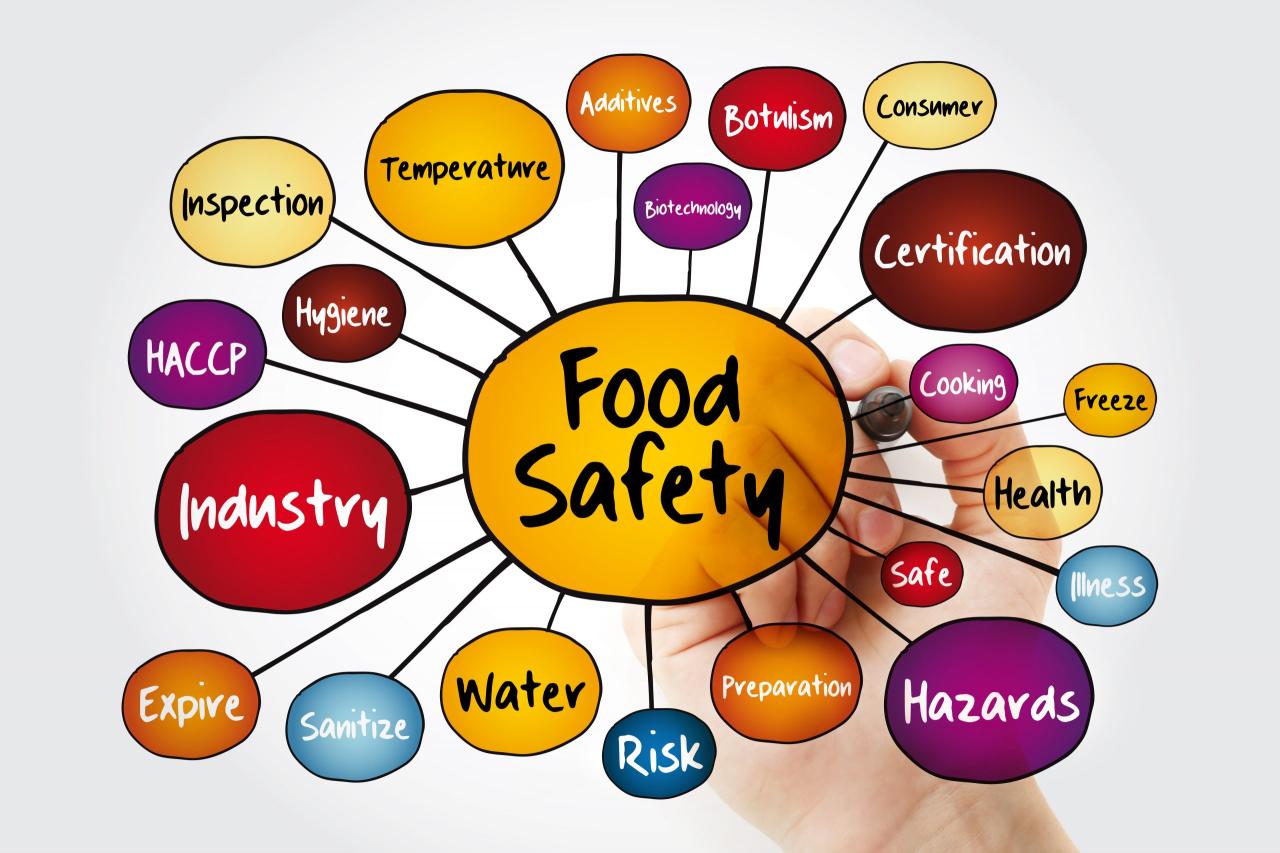Food Technology Safety: A Modern Challenge
Food technology safety is a complex and ever-evolving field that intertwines the advancement of food processing techniques with the paramount need to ensure the safety and quality of our food […]

Food technology safety is a complex and ever-evolving field that intertwines the advancement of food processing techniques with the paramount need to ensure the safety and quality of our food supply. From the use of artificial intelligence in food safety management to the application of nanotechnology in enhancing food quality, technological innovations are transforming the way we produce, process, and consume food. However, these advancements also present unique challenges and require a careful consideration of potential risks and benefits.
The globalized food supply chain, with its intricate networks of producers, processors, and consumers, further complicates the task of ensuring food safety. This interconnectedness necessitates a collaborative approach involving governments, industry stakeholders, and consumers to ensure that food safety standards are maintained throughout the entire chain.
Food Safety Challenges in Modern Food Technology
The rapid advancement of food technology presents both opportunities and challenges for ensuring food safety. While these innovations promise to enhance food production, processing, and distribution, they also introduce new complexities and risks that require careful consideration.
Impact of Emerging Food Technologies on Traditional Food Safety Practices
Traditional food safety practices often focus on controlling physical, chemical, and biological hazards throughout the food chain. However, emerging technologies such as gene editing, nanotechnology, and artificial intelligence (AI) can disrupt these established practices and necessitate new approaches to ensure food safety. For example, gene editing techniques, while promising for enhancing crop yields and nutritional content, raise concerns about potential unintended consequences for food safety, such as the emergence of new allergens or antibiotic resistance. Similarly, nanotechnology, with its applications in food packaging and processing, requires careful evaluation of potential risks associated with nanoparticle toxicity and their impact on human health.
Key Technologies Impacting Food Safety

Food safety is a crucial aspect of modern food production, and technological advancements play a pivotal role in ensuring the safety and quality of food. From innovative preservation techniques to sophisticated monitoring systems, these technologies are transforming the way we produce, process, and consume food.
Food Preservation Technologies
Food preservation technologies aim to extend the shelf life of food products while maintaining their nutritional value and safety. Here are some key technologies that are revolutionizing food preservation:
- Irradiation: This process involves exposing food to ionizing radiation, such as gamma rays or electron beams, to eliminate harmful microorganisms. Irradiation effectively reduces the risk of foodborne illnesses caused by bacteria, parasites, and insects. For example, irradiation is widely used to sterilize spices, meat, and poultry, ensuring their safety and extending their shelf life.
- High-Pressure Processing (HPP): HPP involves subjecting food to high hydrostatic pressure, typically 400-800 MPa, for a specific period. This process inactivates microorganisms without significantly altering the flavor, texture, or nutritional value of the food. HPP is particularly effective for preserving ready-to-eat foods like juices, sauces, and meat products.
- Pulsed Electric Fields (PEF): PEF technology involves applying short, high-voltage pulses to food products. These pulses disrupt the cell membranes of microorganisms, leading to their inactivation. PEF is a non-thermal process that can preserve the flavor and nutritional content of food. It is increasingly used for extending the shelf life of juices, milk, and other liquid products.
Nanotechnology in Food Safety
Nanotechnology offers exciting possibilities for enhancing food safety and quality. Nanomaterials, with their unique properties, can be used for various applications in food production, processing, and packaging.
- Active Packaging: Nanomaterials can be incorporated into food packaging materials to create active packaging systems that can extend shelf life, prevent spoilage, and enhance food safety. For example, nanosensors can be embedded in packaging to detect changes in food quality, such as the presence of pathogens or spoilage gases.
- Food Preservation: Nanoparticles can be used to develop novel food preservation methods. For instance, silver nanoparticles have antimicrobial properties and can be incorporated into food packaging to inhibit microbial growth.
- Food Detection and Analysis: Nanotechnology enables the development of highly sensitive sensors and biosensors for rapid and accurate detection of food contaminants, allergens, and pathogens. These sensors can be used for real-time monitoring of food safety throughout the supply chain.
Sensors and Biosensors for Food Safety Monitoring, Food technology safety
Sensors and biosensors are essential tools for real-time monitoring of food safety. They can detect various parameters, including temperature, pH, moisture, and the presence of contaminants.
- Temperature Sensors: These sensors monitor the temperature of food products throughout the supply chain, ensuring that they are maintained within safe temperature ranges to prevent microbial growth.
- pH Sensors: pH sensors measure the acidity or alkalinity of food products, which is an important indicator of food quality and safety.
- Moisture Sensors: Moisture sensors measure the water content of food products, which can influence microbial growth and product shelf life.
- Biosensors: Biosensors utilize biological components, such as enzymes or antibodies, to detect specific food contaminants or pathogens. They offer high sensitivity and specificity for rapid and accurate detection.
Emerging Technologies for Food Safety
The field of food safety is constantly evolving, with emerging technologies promising to further enhance food safety in the future.
- Artificial Intelligence (AI): AI algorithms can analyze large datasets of food safety information, identifying patterns and trends that may indicate potential risks. This can help in predicting and preventing foodborne outbreaks.
- Blockchain Technology: Blockchain technology can provide a secure and transparent record of food products throughout the supply chain, enabling traceability and accountability. This can help in identifying the source of foodborne outbreaks and preventing future occurrences.
- Gene Editing: Gene editing technologies, such as CRISPR-Cas9, can be used to modify food crops to enhance their resistance to pathogens and pests. This can reduce the need for pesticides and improve food safety.
Food Safety Regulations and Standards: Food Technology Safety

Food safety regulations have evolved significantly over time, reflecting advancements in food technology and a growing understanding of foodborne illnesses. This section explores the evolution of food safety regulations, compares and contrasts standards across different regions, and discusses the role of international organizations in setting global food safety standards.
Evolution of Food Safety Regulations
Food safety regulations have evolved in response to technological advancements and scientific understanding of foodborne illnesses. Early regulations focused on preventing adulteration and ensuring the wholesomeness of food. The advent of industrial food processing and the development of new technologies led to the need for more comprehensive regulations. For example, the development of pasteurization and canning processes in the 19th century led to the introduction of regulations governing these processes.
- Early regulations: Focused on preventing adulteration and ensuring wholesomeness of food.
- Industrial food processing: The rise of industrial food processing in the 20th century led to the need for more comprehensive regulations, addressing hygiene standards, labeling requirements, and food additives.
- Modern regulations: Modern regulations incorporate principles of hazard analysis and critical control points (HACCP) and emphasize risk-based approaches to food safety.
Comparison of Food Safety Standards Across Regions
Food safety standards vary across different countries and regions due to factors such as cultural practices, economic conditions, and regulatory frameworks.
- European Union: The EU has a comprehensive system of food safety regulations, including the General Food Law and the Food Safety Authority (EFSA), which sets standards for food production, processing, and distribution.
- United States: The US Food and Drug Administration (FDA) and the United States Department of Agriculture (USDA) are responsible for food safety regulations in the United States.
- Developing countries: Developing countries often have less stringent food safety regulations and may lack the resources to effectively enforce them.
Role of International Organizations
International organizations play a vital role in setting global food safety standards and promoting international cooperation on food safety issues.
- Codex Alimentarius: The Codex Alimentarius Commission, established by the Food and Agriculture Organization (FAO) and the World Health Organization (WHO), develops international food standards, guidelines, and codes of practice to protect consumer health and ensure fair practices in food trade.
- World Trade Organization (WTO): The WTO’s Agreement on the Application of Sanitary and Phytosanitary Measures (SPS Agreement) sets rules for countries to use food safety regulations, ensuring that they are not used as disguised trade barriers.
Challenges of Enforcing Food Safety Regulations in the Context of Emerging Technologies
Emerging technologies, such as nanotechnology, gene editing, and artificial intelligence, present new challenges for food safety regulations.
- New food products: Emerging technologies can lead to the development of new food products with novel properties, requiring new regulations to ensure their safety.
- Complex supply chains: Globalized food supply chains, enabled by emerging technologies, can make it more difficult to trace food products and enforce regulations.
- Data security: Emerging technologies, such as the Internet of Things (IoT), can generate large amounts of data that can be used to improve food safety. However, it is essential to ensure the security of this data.
Consumer Awareness and Education
Consumer awareness and education play a crucial role in ensuring food safety. When consumers are informed about proper food handling practices, they can make informed choices to protect themselves and their families from foodborne illnesses.
Key Food Safety Information
This table Artikels essential food safety information that consumers should be aware of:
| Category | Key Information |
|—|—|
| Storage | – Store raw meat, poultry, and seafood separately from ready-to-eat foods to prevent cross-contamination.
– Refrigerate perishable foods promptly after purchase.
– Freeze foods that won’t be used within a few days.
– Follow recommended storage temperatures for different types of foods. |
| Handling | – Wash hands thoroughly with soap and water before and after handling food.
– Wash surfaces, utensils, and cutting boards with hot, soapy water after each use.
– Avoid cross-contamination by using separate cutting boards for raw meat and produce.
– Keep raw meat, poultry, and seafood separate from other foods in the shopping cart and at home. |
| Preparation | – Cook foods to the recommended internal temperatures to kill harmful bacteria.
– Use a food thermometer to check the internal temperature of meat, poultry, and fish.
– Avoid cross-contamination by using separate utensils for raw and cooked foods.
– Wash fruits and vegetables thoroughly before eating. |
Educational Materials for Diverse Audiences
Designing effective educational materials requires tailoring the message to the specific audience. For instance:
* Infographics: These visually appealing graphics can convey key food safety messages in a concise and engaging manner. They are particularly effective for reaching younger audiences and those who prefer visual learning.
* Videos: Short, informative videos can demonstrate proper food handling techniques and provide practical tips. They can be easily shared on social media platforms and are accessible to a wide range of audiences.
* Interactive Online Modules: These modules can provide a more immersive learning experience, allowing users to test their knowledge and receive personalized feedback. They are particularly suitable for engaging audiences with different learning styles.
* Community Outreach Programs: Collaborating with community organizations and local schools can provide opportunities to deliver food safety messages directly to target audiences. These programs can include workshops, cooking demonstrations, and educational materials in multiple languages.
Social Media and Online Platforms
Social media platforms and online resources have become powerful tools for raising awareness about food safety issues.
* Public Health Agencies: Many public health agencies use social media to disseminate food safety information, share alerts about outbreaks, and promote educational campaigns.
* Food Industry Organizations: Food industry organizations can leverage social media to communicate best practices, respond to consumer inquiries, and build trust in their products.
* Food Bloggers and Influencers: Food bloggers and influencers can reach large audiences and can play a significant role in promoting food safety awareness by sharing tips, recipes, and information about food safety practices.
Impact of Consumer Perception
Consumer perception plays a significant role in food safety choices.
* Trust in Food Sources: Consumers are more likely to follow food safety guidelines if they trust the source of the information. This trust can be built through transparency, clear communication, and a commitment to food safety.
* Awareness of Risks: Consumers who are aware of the potential risks associated with foodborne illnesses are more likely to take precautions. This awareness can be fostered through educational campaigns, media coverage of food safety issues, and personal experiences with foodborne illnesses.
* Perception of Convenience: Consumers may be more likely to take shortcuts with food safety practices if they perceive them as inconvenient. This can be addressed by providing practical tips and tools that make food safety practices easier to implement.
Case Studies and Future Trends

The evolution of food technology has brought about significant advancements in food safety, but it has also presented new challenges. By examining real-world incidents and analyzing the lessons learned, we can gain valuable insights into the future of food safety and how emerging trends will shape the industry.
Food Safety Incidents Related to Technological Advancements
Technological advancements in food production and processing have undeniably improved food safety, but they have also introduced new risks. Several high-profile food safety incidents have highlighted the importance of robust safety protocols and the need for continuous adaptation to evolving technologies.
- The 2011 Listeria outbreak linked to cantaloupe in the United States was a stark reminder of the potential for contamination in fresh produce. The outbreak was traced back to a single farm in Colorado, where contaminated water was used to wash the cantaloupe. This incident led to the development of stricter food safety regulations for fresh produce, including increased testing and improved sanitation practices.
- The 2015 Salmonella outbreak linked to peanut butter in the United States was another example of a food safety incident linked to technological advancements. The outbreak was traced back to a single factory in Georgia, where contaminated peanut butter was produced. This incident highlighted the importance of food safety management systems and the need for robust quality control measures.
Lessons Learned from Food Safety Incidents
These food safety incidents have taught us valuable lessons about the importance of:
- Proactive Risk Assessment: Identifying and mitigating potential hazards early on is crucial to prevent food safety incidents. This involves conducting thorough risk assessments, considering all stages of the food supply chain, from farm to table.
- Robust Food Safety Management Systems: Having a comprehensive food safety management system in place is essential for ensuring the safety of food products. This includes establishing clear procedures for food handling, processing, and storage, as well as implementing effective quality control measures.
- Continuous Improvement and Adaptation: The food industry must be constantly adapting to new technologies and evolving food safety challenges. This involves staying abreast of emerging risks, updating food safety practices, and investing in research and development.
Key Trends Shaping the Future of Food Technology and Safety
Several key trends are shaping the future of food technology and safety, with the potential to significantly impact the food industry and consumers.
- Artificial Intelligence (AI): AI is being used to improve food safety in various ways, including identifying potential foodborne hazards, optimizing food production processes, and enhancing food traceability. For example, AI-powered systems can analyze vast amounts of data from food safety inspections, production records, and consumer feedback to identify potential risks and predict outbreaks.
- Blockchain Technology: Blockchain technology can enhance food traceability, enabling consumers to track the journey of their food from farm to table. This can help to identify the source of foodborne outbreaks more quickly and effectively, reducing the impact on public health.
- Precision Agriculture: Precision agriculture uses technology to optimize crop yields and minimize food waste. This can help to reduce the risk of foodborne illness by improving the quality and safety of agricultural products.
- Nanotechnology: Nanotechnology is being used to develop new food packaging materials that can extend shelf life, reduce spoilage, and improve food safety. For example, nanomaterials can be used to create antimicrobial coatings that prevent the growth of bacteria on food surfaces.
Impact of Emerging Trends on the Food Industry and Consumers
These emerging trends have the potential to significantly impact the food industry and consumers in several ways.
- Improved Food Safety: These technologies can help to reduce the risk of foodborne illness and improve the overall safety of the food supply.
- Increased Transparency and Traceability: Consumers will have greater access to information about the origin and journey of their food, empowering them to make informed choices.
- Enhanced Sustainability: These technologies can help to reduce food waste, improve resource efficiency, and promote sustainable food production practices.
- New Product Innovations: These advancements will lead to the development of new food products and innovative solutions to food safety challenges.
Epilogue
As we navigate the exciting yet complex landscape of food technology, it is imperative to prioritize food safety. By understanding the challenges and opportunities presented by emerging technologies, we can work towards a future where innovation and safety go hand in hand. This requires continuous research, development, and collaboration among all stakeholders to ensure that our food supply remains safe, nutritious, and accessible to all.
Food technology safety is crucial for ensuring the quality and safety of our food supply. From advanced processing techniques to intelligent packaging, technology plays a vital role in this area. But just like food technology, car technology is also advancing rapidly.
For example, you might be interested in learning about the features included in the Acura MDX technology package. Similarly, food technology safety is constantly evolving, and it’s essential to stay informed about the latest advancements to protect our health and well-being.




